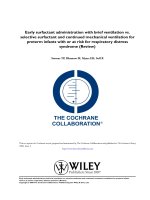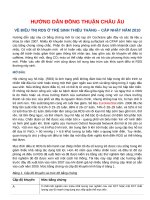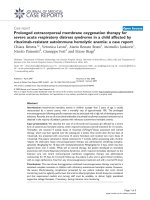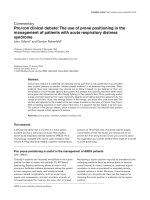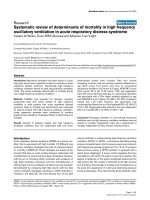Treatment results of respiratory distress syndrome in preterm infants at the Pediatric Center of Hue Central Hospital
Bạn đang xem bản rút gọn của tài liệu. Xem và tải ngay bản đầy đủ của tài liệu tại đây (510.6 KB, 6 trang )
Bệnh viện
Trung ương
Huế
Treatment results of respiratory distress syndrome
in preterm
infants...
Original Research
DOI: 10.38103/jcmhch.83.5
TREATMENT RESULTS OF RESPIRATORY DISTRESS SYNDROME IN
PRETERM INFANTS AT THE PEDIATRIC CENTER OF HUE CENTRAL
HOSPITAL
Tran Kiem Hao1, Nguyen Thi Thao Trinh1, Nguyen Van Dien1, Hoang Mai Linh1
1
Pediatric Center, Hue Central Hospital
ABSTRACT
Background: Acute respiratory distress syndrome (ARDS) in premature infants is one
of the leading causes of death. Surfactant replacement therapy has been the mainstay of
treatment for preterm infants with RDS. This study aimed to evaluate the results of surfactant
therapy for premature infants with RDS at the Pediatric Center of Hue Central Hospital.
Methods: A prospective, descriptive, and comparative study was conducted on 52
preterm infants with RDS based on clinical and chest radiographic findings before and after
intervention. All infants received conventional surfactant therapy or INSURE. Evaluation of
treatment results after 6 hours based on: SpO2, FiO2, a/APO2, and chest X-ray.
Results: Surfactant treatment markedly reduced the need for FiO2 and Surfactant
Received:
10/06/2022
Accepted:
24/08/2022
Corresponding author:
Tran Kiem Hao
Email:
Phone: 0914002329
treatment markedly reduced FiO2. requirement and improved SpO2. The average
SpO2 of 91.15% increased to 95.67%. The average FiO2 of 51.54% decreased to
40.5%. Lung lesions on X-ray have markedly improved after treatment, as shown in
the improvement of lesions. Alveolar and arterial oxygen rates (a/APO2) improved
significantly after surfactant administration. 33/52 (63.5%) cases eventually improved
within 6 hours after treatment without any complications.
Conclusion: A surfactant replacement that counterbalances surfactant inactivation
seems to improve oxygenation and lung function in many preterm infants with
respiratory distress syndrome without any apparent negative side effects.
I. INTRODUCTION
Respiratory distress syndrome (RDS), formerly
known as hyaline membrane disease, is one of the
most common medical emergencies in preterm
neonates resulting from lung immaturity. This
disorder accounted for 1% of all infants and 5-10%
of preterm ones. Additionally, the risk is highest in
preterm infants or those weighing less than 1200
grams [1-3].
In VietNam, RDS in preterm neonates is one of
the most leading causes of respiratory failure and
death. According to the World Health Organization
and United Nations Children’s Fund, there are
approximately 18000 newborn deaths annually, of
which 35% are due to preterm birth complications,
and RDS is primarily the leading cause [4].
Nowadays, the use of surfactants is applied
in many hospitals. Much research on the use of
32
surfactants is “common” in many hospitals such
as Vietnam National Children’s Hospital, Tu Du
Hospital, Children’s Hospital 1, Dong Nai Hospital,
showing potential results [5].
We conducted this research to evaluate surfactants’
effectiveness in managing RDS in preterm infants in
Pediatric center of Hue Central Hospital.
II. MATERIALS AND METHODS
2.1. Study population
The diagnosis of RDS in preterm infants consists
of the following 2 criteria:
- Two or more signs of increased work of breathing
within 6 hours, including: (1) newborn’s respiratory
rate > 60 breaths per minute or <30 breaths per
minute; (2) chest retractions; (3) grunting.
- The typical radiographic features of neonatal
RDS in a preterm infant [6].
Journal of Clinical Medicine - No. 83/2022
Hue Central Hospital
Therapeutic indications for surfactant replacement therapy include [7]: Neonates born before 29
weeks: required CPAP and FiO2 ≥ 30%; or need
to be intubated with FiO2 ≥ 30%; or those born
before 26 weeks required positive pressure ventilation. Neonates born after 29 weeks: required CPAP
and FiO2 ≥ 40%; or need to be intubated with FiO2
≥ 40% and mean airway pressure ≥ 7 cmH2O.
Exclusion criteria: Infants with congenital anomalies of the respiratory system or other accompanied
respiratory diseases. Infants who needed resuscitation at birth and then died.
Location and survey period: Pediatric center –
Hue Central Hospital from 6/2020 to 10/2021.
2.2. Methods
A prospective, descriptive, and comparative
study was conducted on 52 newborns who met the
mentioned criteria.
The standard technique for surfactant
administration: A sonde is cut to a standard length
that is 0,5 – 1 cm shorter than the endotracheal
tube. At the next stage, a medical practitioner draws
up the required dose of surfactant into a syringe.
After attaching the pre-cut sonde to the syringe,
the practitioner fills the sonde with surfactant to the
end. Then, an assistant disconnects the endotracheal
tube from the ventilator and the medical practitioner
administers the surfactant via the pre-cut tube within
2-3 seconds. Following instillation, the patient is
reconnected to the ventilator. Unless significant
airway obstruction occurs, medical staff do not
suction airways for 1 hour after surfactant instillation.
INSURE technique for surfactant administration
[8]: Infants are intubated with an appropriate size
endotracheal tube and surfactant is administered as
in standard technique. However, Extubation takes
place when premature neonates are stable with
SpO2 >90%. After extubation, CPAP with PEEP
5-7 cmH20 is started in these patients, depending
on the clinical manifestations and SpO2, to adjust
possible FiO2 and PEEP to maintain SpO2 ≥ 90%.
The evaluation of treatment after 6 hours
involves:
- Clinical response: depending on the infants’
requirement of FiO2 to maintain SpO2 ≥ 90%.
- Chest x ray improvement.
2.3. Statistical analysis
Data were analyzed using SPSS 26.0. To
evaluate the treatment response, we compare SpO2,
FiO2 and a/APO2 before and after treatment using
paired sample T test
a/APO2 =
PaO2
(713xFiO 2 – 1,25xPaCO2 )
[9]
Making comparisons of respiratory failure
levels and chest x-ray findings before and after
surfactant administration to indicate: improvement,
no improvement and deterioration.
III. RESULTS
3.1. General characteristics
Table 1: Gestational age distribution of births
Gestational age
Number of
Rate (%)
(weeks)
patients (n)
< 28
12
23.1
28 – <32
28
53.8
32 – <34
7
13.5
34 – <37
5
9.6
Total
52
100
Neonates born between 28 and 32 weeks had the
highest disease incidence, with 53.8%.
Table 2: Distribution of birth weight
Birth weight
Number of
Rate (%)
(gram)
patients (n)
<1000
11
21.1
1000 – <1500
23
44.2
1500 – <2500
17
32.7
2500 – <4000
1
1.9
Total
52
100
Neonates who were born weighing between
1000 and 1500 grams had the highest incidence of
the disease, with 44.2%.
Table 3: The time interval from birth to
disease onset
Number of
Time interval
Rate (%)
patients (n)
Less than 1 hour
49
94.2
More than 1 hour
3
5.8
Total
52
100
The onset of respiratory failure occurred within
1 hour after delivery, with 94.2%.
Table 4: Methods of respiratory support
Journal of Clinical Medicine - No. 83/2022
Methods of
respiratory support
Number of
patients (n)
Rate (%)
Nasal Cannula
8
15.4
CPAP
Mechanical
Ventilation
15
28.8
29
55.8
33
Treatment results of respiratory distress syndrome
Bệnh viện
in preterm
Trung ương
infants...
Huế
Methods of
respiratory support
Number of
patients (n)
Rate (%)
Total
52
100
All infants with RDS required respiratory
support, in which mechanical ventilation accounts
for 55.8%.
Table 5: Radiographic stage of chest x-ray
Number of
Rate
Radiographic stage
patients (n)
(%)
Stage 2
20
38.5
Stage 3
21
40.4
Stage 4
11
21.2
Total
52
100
Most chest x ray in these patients showed
radiographic findings in stage 2 and 3. Additionally,
the proportion of patients with radiographic findings
in stage 4 was 21.2% and there was no patient with
chest x ray in stage 1.
3.2. Evaluation of surfactant replacement
therapy effects
Table 6: Methods of surfactant administration
Number of
Methods
Rate (%)
patients (n)
Standard technique
38
73.1
INSURE
14
26.9
Total
52
100
INSURE method was used in 14/52 neonates,
accounting for 26.9%, compared with 38/52 (73.1%)
patients using the standard technique for surfactant
administration.
Table 7: Changes in SpO2 and FiO2 in groups of
patients
Before
6 hours after
instillation instillation
p
(n)
(n)
n
%
n
%
SpO2 < 90% 14 26.9
3
5.8
<
0.05
SpO2 ≥ 90% 38 73.1
49
94.2
FiO2 ≤ 40% 21 40.4
25
48.1
>
0.05
FiO2 > 40% 31 59.6
27
51.9
Before instillation, 14 of 52 patients had less
than 90% oxygen saturation. However, the figure
decreased to only 3 patients after instillation. The
average SpO2 increased from 91.15% to 95.67%
after surfactant administration. Additionally, 31 of
all neonates required FiO2 ≥ 40%, which reduced
34
to 27/52 after instillation, and the average demand
for FiO2 declined from 51.54% to 40,50%. The
improvement of SpO2 was statistically significant.
Table 8: Changes in arterial/alveolar oxygen
tension ratio (a/APO2)
Second
First time
p
time
a/APO2
0.21 ± 0.13 0.26 ± 0.15 < 0.05
The improvement of a/APO2 was statistically
significant.
Table 9: Changes in radiographic stage in chest x
ray of the neonates
Number
Rate
Results
of patients
(%)
(n)
Improvement
47
90.4
No improvement
4
7.7
Deterioration
1
1.9
Total
52
100
Most patients after surfactant administration
showed improvement in chest x ray findings. Only
4 patients (7.7%) showed no improvement and 1
newborn (1.9) presented the deterioration.
Table 9: Results after 6 hours of treatment
Number of
Rate
Results
patients (n)
(%)
No improvement
19
36,5
Improvement
33
63,5
Total
52
100
There was a significant improvement in 33
newborns after being treated with surfactant,
accounting for 63,5%.
3.3. The factors related to treatment outcomes
Table 10: The correlation between treatment
outcome and gestational age
No improImproGestational
vement
vement
p
age
n
%
n
%
Extremely
8
15.4
4
7.7
preterm
Very preterm
10
19.2 18 34.6
<
Moderate
1
1.9
6
11.5 0.05
preterm
Late preterm
0
0
5
9.6
Total
19
36.5 33 63.5
Journal of Clinical Medicine - No. 83/2022
Hue Central Hospital
The later gestational age, the greater possibility of
improvement.
Table 11: The correlation between treatment
outcome and birth weight
No improImproBirth
vement
vement
p
weight
n
%
n
%
Extremely
low birth
weight
Very low
birth
weight
Low birth
weight
Normal
8
15.4
3
5.8
7
13.5
16
30.8
4
7.7
13
25.0
0
0
1
1.9
<
0.05
Total
19
36.5
33
635
The improvement ratios in normal and low-weight
newborns are higher than the figure for very low
birth weight and extremely low birth weight.
Table 12: The correlation between treatment
outcome and radiographic stage on x ray
No improImprovement
vement
Stage
p
n
%
n
%
2
4
7.7
16
30.8
3
9
17.3
12
23.1
4
6
11.5
5
9.6
>
0.05
Total
19
36.5
33
63.5
The correlation between treatment outcome
and the radiographic stage was not statistically
significant.
IV. DISCUSSION
4.1. Methods of surfactant administration
In Vietnam, we currently use three techniques of
surfactant administration: Conventional surfactant
therapy is used for infants of low gestational age and
low birth weight because these infants frequently
have severe dyspnea that prevents effective
spontaneous breathing. INSURE and LISA, each
with its unique benefits, are available to newborns at a
higher gestational age. The strategy to intubate, give
surfactant, and extubate (INSURE) has been widely
accepted in clinical practice. The disadvantage of
this technique remains the need for intubation and
positive pressure ventilation during the procedure.
In some cases, the endotracheal tube could not be
removed after this therapy. Additionally, even brief
periods of invasive mechanical ventilation still
cause harm to the immature lungs of the preterm
neonate. These factors contribute to the delay in
the INSURE method indication. Another technique
developed to address this issue is less invasive
surfactant administration (LISA), also known
as minimally invasive surfactant therapy (MIST). It
aims to make the procedure as minimally invasive
as possible.
In our study, we used 2 methods for surfactant
replacement therapy: the conventional method
and the INSURE method. One of the concerns of
clinicians is the regurgitation of surfactant during
the procedure, particularly when using minimally
invasive surfactant therapy and no mechanical
ventilation at all. While the newborn breathes
naturally with CPAP support, the surfactant is
administered into the trachea. That is one of the
main barriers keeping physicians from applying
the LISA approach. As a result, 38 patients in our
research received the conventional technique,
accounting for 73.1%, and the remaining 14
patients we performed by INSURE technique
accounted for 26.9%.
4.2. Change in SpO2 value and FiO2 requirement
in patients
A marked improvement in SpO2 value and
FiO2 requirements can be seen in patients receiving
surfactant administration, with the improvement in
SpO2 being particularly statistically significant. The
increase in SpO2 and the decrease in FiO2 demand
reflect the improvement of lung function after
surfactant therapy. The effectiveness of surfactants
acts in three phases: acute response occurring after
a few minutes, effects occurring over several hours,
and effects lasting for several days. The surfactantinduced lung expansion results in a quick rise in
oxygen saturation that might happen immediately.
The subsequent response to surfactant therapy
results from improved lung mechanics, which
takes longer and depends in part on the mode of
ventilation.
The obvious improvement of SpO2 and FiO2 after
surfactant treatment was also reported in a study by
Tran Thi Thuy at Bac Ninh Maternity and Paediatric
Hospital [10], a study by Nguyen Viet Dong at Ha
Tinh Provincial General Hospital [11], and a study by
Vo Tuong Van at Children’s Hospital 2 [12].
Journal of Clinical Medicine - No. 83/2022
35
Treatment results of respiratory distress syndrome
Bệnh viện
in preterm
Trung ương
infants...
Huế
4.3. Change in a/APO2
According to a study by Mats Blennow et al.,
infants > 27 weeks of gestational age with acute
respiratory distress syndrome were intubated and
treated with surfactant when the a/APO2 ratio was
below 0.22. a/APO2 increased from 0.2 to 0.5 after
1 hour of surfactant therapy and stayed there for
48 hours. The study by Verder et al. showed that
children with acute respiratory distress syndrome
who received early surfactant treatment (a/APO2
ranged from 0.22 to 0.35, mean 0.26) had a lower rate
of needing mechanical ventilation and mortality than
the group who received treatment later. Therefore,
surfactants are recommended early for children with
acute respiratory distress syndrome [13].
According to our results, the index a/APO2
at the time after surfactant treatment was 0.26,
significantly increased compared to before treatment
was 0.21. This shows an improvement in lung gas
exchange following surfactant therapy. Our findings
are consistent with the results of Vo Tuong Van at
Children’s Hospital 2 [12].
4.4. Change in disease severity on Chest X-ray
In our study, most patients had improved lung
lesions on chest X-rays following surfactant therapy,
accounting for 90.4% of cases. The degree of lung
injury was significantly reduced after surfactant
therapy. Clinical improvements in dyspnea
following therapy are consistent with improvements
in lung damage. However, there are also cases of
lung damage that did not get better after treatment.
The cause of these cases was that the patient was
critically ill and had high FiO2 requirements of up
to 100% on admission. In the study of Hoang Thi
Thanh Mai [14] at Bach Mai hospital, pre-treatment
results on straight chest x-ray showed respiratory
distress syndrome (RDS) grade II accounted for
the highest rate of 46.7%, grade III was 33.3%,
and grade IV was 20% (6/30 cases). There was a
noticeable improvement in the first 24 hours of
therapy, grade 3 and 4 disease is no longer present.
After 48 hours of treatment, the results showed that
only 11.8% of the patients on X-ray were grade 1,
and 88.2% had no signs of lung damage. Research
by Pham Van Anh at the Maternity and Paediatric
Hospital in Quang Ngai province also showed a
96.5% improvement in chest X-ray results [15].
4.5. Overall outcome of surfactant replacement
therapy
In our study, 33 cases of improvement following
therapy accounted for 63.5%. The results are close
36
to those of studies by Nguyen Thanh Thien [16]
at Children’s Hospital 2 and Le Thi Thuy Loan
[17] at Can Tho Children’s Hospital, with success
rates of mechanical ventilation of 76,9% and 66%,
respectively. Although follow-up time varied
between studies, their results were similar, indicating
a rapid response to surfactant after administration.
In our study, no complications were recorded.
The limitation of our study is that we did not
evaluate throughout the course of treatment
to assess all the complications of the disease
as well as the complications of the surfactant
administration process.
V. CONCLUSION
Surfactant treatment markedly reduced FiO2
requirement and improved SpO2. The average SpO2
of 91.15% increased to 95.67%, and the average
FiO2 requirement of 51.54% decreased to 40.5%.
Lung damage on X-ray also improved significantly
after treatment, as shown in the improvement
of lesion grading (90.4%). Alveolar and arterial
oxygen rates (a/APO2) improved significantly after
surfactant administration. 33/52 (63.5%) cases
eventually improved within 6 hours after treatment
without complications.
REFERENCES
1. De Luca D. Respiratory distress syndrome in preterm neonates
in the era of precision medicine: A modern critical care-based
approach. Pediatr Neonatol. 2021. 62 Suppl 1: S3-S9.
2. Ghafoor T, Mahmud S, Ali S, Dogar SA. Incidence of
respiratory distress syndrome. J Coll Physicians Surg Pak.
2003. 13: 271-3.
3. McPherson C , Wambach JA. Prevention and Treatment
of Respiratory Distress Syndrome in Preterm Neonates.
Neonatal Netw. 2018. 37: 169-177.
4. Lê Nguyễn Nhật Trung. Kết quả điều trị trẻ sơ sinh sinh non
26 – 34 tuần tuổi thai Tại bệnh viện Nhi Đồng 2. Tạp chí Y
học Thành phố Hồ Chí Minh. 2016. 2: 15 – 23.
5. Nguyễn Trọng Hiếu. Liệu pháp Surfactant thay thế trong dự
phòng và điều trị hội chứng suy hô hấp ở trẻ so sinh thiếu
tháng. Thời sự Y Dược. 2005. 10: 132- 134.
6. Yadav S, Lee B, Kamity R, Neonatal Respiratory Distress
Syndrome, in StatPearls. 2022: Treasure Island (FL).
7. Ng EH , Shah V. Guidelines for surfactant replacement
therapy in neonates. Paediatr Child Health. 2021. 26: 35-49.
8. Awaysheh F, Alhmaiedeen N, Al-Ghananim R, Bsharat A,
Al-Hasan M. Criteria for Using INSURE in Management
of Premature Babies with Respiratory Distress Syndrome.
Med Arch. 2019. 73: 240-243.
Journal of Clinical Medicine - No. 83/2022
Hue Central Hospital
9. Hsu JT, Chu CM, Chang ST, Cheng HW, Lin PC, Hsu TS,
et al. Prognostic value of arterial/alveolar oxygen tension
ratio (a/APO2) in acute pulmonary embolism. Circ J. 2007.
71: 1560-6.
10.Trần Thị Thủy. Kết quả phương pháp INSURE trong điều
trị hội chứng suy hô hấp ở trẻ đẻ non tại Bệnh viện Sản Nhi
Bắc Ninh năm 2017. Tạp chí Khoa học ĐHQGHN, Khoa
học Y Dược. 2017. 33: 106-114.
11. Nguyễn Viết Đồng. Điều trị bệnh màng trong ở trẻ đẻ non
bằng liệu pháp surfactant tại khoa Nhi bệnh viện Đa Khoa
Hà Tĩnh. Tạp chí Nhi Khoa. 2019. 2: 28 – 38.
12.Võ Tường Văn. Kết quả sử dụng surfactant ở bệnh nhên sơ
sinh non tháng bệnh màng trong tại Khoa Hồi sức sơ sinh
bệnh viện Nhi Đồng 2. tạp chí Y Học TP Hồ Chí Minh.
2016. 20: 15 – 19.
13.Verder H, Albertsen P, Ebbesen F, Greisen G, Robertson
B, Bertelsen A, et al. Nasal continuous positive airway
pressure and early surfactant therapy for respiratory distress
syndrome in newborns of less than 30 weeks’ gestation.
Pediatrics. 1999. 103: E24.
14.Hoàng Thị Thanh Mai. Bước đầu đánh giá hiệu quả của
surfactant điều trị bệnh màng trong ở trẻ đẻ non tại khoa sơ
sinh bệnh viện Nhi Trung ương, Luận văn tốt nghiệp bác sỹ
nội trú, trường Đại Học Y Hà Nội. 2006.
15.Phạm Vân Anh. Đánh giá kết quả điều trị bệnh màng trong
ở trẻ sơ sinh non tháng bằng liệu pháp surfactant tại bệnh
viện Sản - Nhi tỉnh Quảng Ngãi. Tạp chí Y học Việt Nam.
2021. 502: 23 – 27.
16.Nguyễn Thanh Thiện. Kết quả điều trị của kiểu thở A/C VC
ở trẻ sơ sinh non tháng bệnh màng trong tại khoa hồi sức sơ
sinh bệnh viện Nhi Đồng 2. Tạp chí Y học TPHCM. 2018.
22: 33 – 39.
17.Lê Thị Thúy Loan. Đặc điểm lâm sàng, cận lâm sàng và kết
quả điều trị SHH cấp do bệnh màng trong ở trẻ sơ sinh non
tháng tại bệnh viện Nhi Đồng Cần Thơ. Tạp chí Y Dược
Cần Thơ. 2018. 15: 10 – 20.
Journal of Clinical Medicine - No. 83/2022
37
